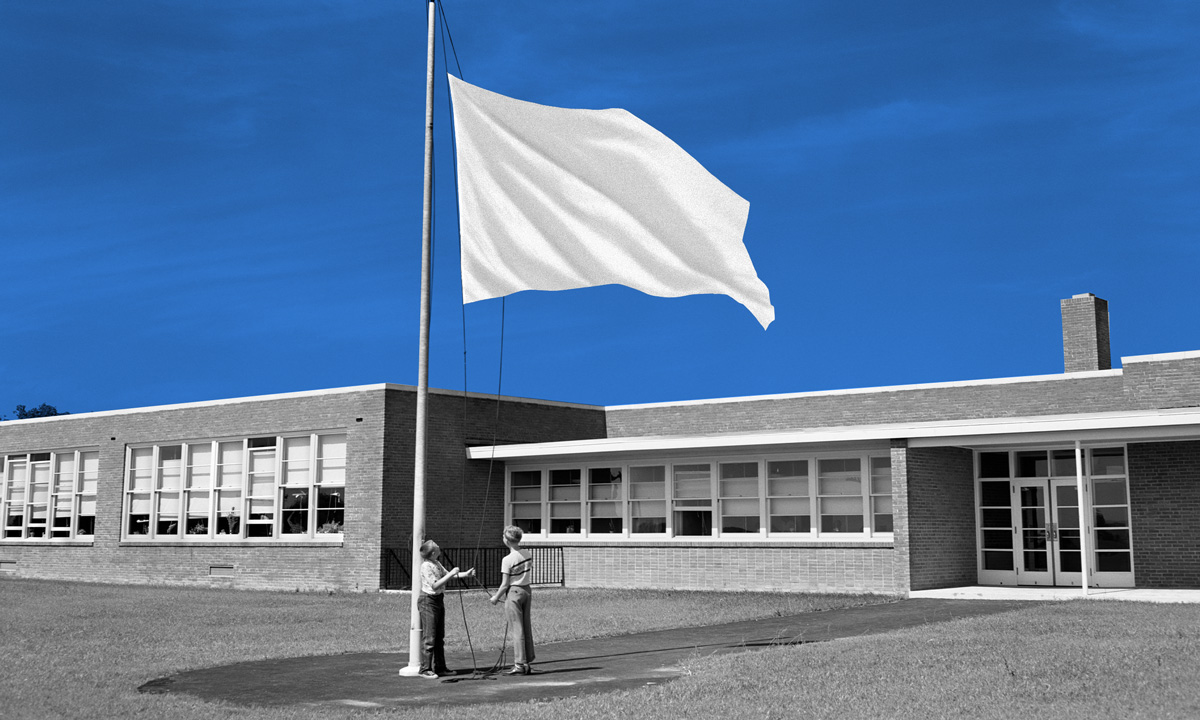The Need to Reboot and Reemphasize Civics Instruction Has Never Been Greater
Finn: Civic ignorance is a silent killer, akin to high blood pressure: easy to ignore even as it hastens the onset of more serious maladies.

Get stories like this delivered straight to your inbox. Sign up for The 74 Newsletter
This is the second part of a two-part essay on the need to reengage with civics education in the United States. Read the first part right here.
American education, both K-12 and postsecondary, has long needed to reboot and reemphasize instruction in civics and citizenship. But that need has never been greater than today, as disunion, disruption and disbelief come to characterize so many elements of American life. Schools alone cannot cure society’s ills, but they could do far more to rectify people’s ignorance about the principles, practices and origins of our democratic republic and the responsibilities and rights of its citizens.
A number of worthy efforts to address this challenge are underway, including the development of new academic standards and curricula for the public schools. Among the most prominent of these are Educating for American Democracy, a curricular roadmap created by a bipartisan team of scholars and educators under the aegis of iCivics, and the “American Birthright” K-12 social studies standards created by the Civics Alliance under the aegis of the National Association of Scholars.
While the roadmap concentrates on inquiry and understanding, posing myriad questions about civics and history that students should grapple with, “American Birthright” is chockablock with content — names, dates, events and concepts that students should know. Each offers a framework on which to hang a complete K-12 curriculum, and I believe an amalgamation of their divergent approaches would tap into a nascent consensus among American parents about what their children should learn.
But instead of seeking common ground and striving for a unified approach to revitalizing this essential subject, some seem to prefer conflict. Call them culture warriors or not, they work at finding fault. From the right, for instance, the Civics Alliance slams the College Board’s excellent Advanced Placement course in civics and American government — developed with the National Constitution Center and anchored to Supreme Court decisions — because it includes an “action” component. The lead author of “American Birthright” gave Educating for American Democracy’s roadmap an F-plus with the accusation that it harbors “a very large amount of radical action civics.” He similarly denounces all forms of “bipartisan cooperation” in this realm because “the radicals conceive of ‘civics’ as a means to eliminate their political opponents from the public square.”
The roadmap has been also faulted by progressive academics, for leaving curriculum (and test) development to state and local sources, rather than propagating a national plan, and being too soft on social justice issues. And EAD is trying to fend off initiatives from the left that it sees as incompatible with the more-or-less centrist path it is trying to follow. For example, Biden administration’s priorities for a grant program meant to foster civics education, seek more attention to “racially, ethnically, culturally, and linguistically diverse perspectives” than the consensus-minded roadmap supplies.
Educators, too, sometimes add to the discord and suspicion, because many teachers don’t view these subjects the same way many parents and voters do. As Frederick Hess and Michael McShane note in their new book, Getting Education Right, drawing on a RAND survey of social studies teachers, “Barely half deemed it essential that students understand concepts like the separation of powers or checks and balances.” A broader RAND survey of K-12 instructors found “that more … think civics education is about promoting environmental activism than ‘knowledge of social, political and civic institutions.’ ”
Is the potential juice — a consensus-based reboot of civics education — worth so many squeezes? Why keep struggling to fend off culture warriors and redirect instructors? Earlier efforts at civics revival have had meager impacts, petered out or been reversed, and the quest for concord is slower and a lot less fun than hurling brickbats.
So why persist? The country has muddled through for decades despite the fact that Americans know next to nothing about civics or history — what editorial cartoonist Pat Oliphant once called a “forest fire of ignorance.” Never mind that just 22% of eighth-graders scored as proficient in civics on the recent National Assessment of Educational Progress and barely 25% of college-age Americans know that the vice president breaks ties in the Senate. (More think that’s the responsibility of the speaker of the House!) How much does it really matter in the real world that they understand so little about government?
Yet, having muddled through yesterday is no guarantee of successful muddling tomorrow. The nation’s citizenship woes grow more consequential as people’s faith in democracy itself falters. YouGov reported late last year that almost a third of young Americans agree — many of them strongly — that “democracy is no longer a viable system, and America should explore alternative forms of government.”
Why believe in something you barely understand or were never taught and feel you have no role in?
Civic ignorance is a silent killer, akin to high blood pressure, easy to ignore or take for granted even as it accompanies and hastens the onset of more serious maladies. Deteriorating norms of behavior, vulnerability to fake news and conspiracy theories, inability to compromise, isolation from civil society — all are associated with not knowing or caring much about the functions of government, the principles that underlie it or the historical saga that explains why we have the kind we do, where it has succeeded, where it has faltered, how it has changed.
Over time, like persistent hypertension, accumulated ignorance makes a difference. As Americans huddle in separate ideological (and socioeconomic and ethnographic) silos and accustom ourselves to cruder language and worse conduct, especially in the public square — “defining deviancy down,” as famously phrased by my mentor, the late Sen. Daniel Patrick Moynihan — civic and citizenship challenges mount. It’s no surprise that people, especially the young, grow more cynical and pessimistic, more open to alternatives such as strong leaders who don’t have to bother with messy elections of the ”free and fair” variety.
Because people’s attitudes and actions in the civics-and-citizenship realm are shaped by a hundred forces, schools bear limited responsibility. But when it comes to old-fashioned ignorance, formal education has a big role — and was playing it poorly before anyone heard of culture wars. For decades, civics has loomed small in the curriculum, standards have been low, requirements few (and declining), instructors often ill-prepared. In few places are schools, teachers or students held to account for whether anything gets learned. Rare is the college that requires its students to study civics, and almost as rare are colleges that even offer such courses.
Yes, most high schoolers must take a course in civics or government — though a dozen states have no such graduation requirement, and most of those that do mandate just a single semester. Some administer a statewide end-of-course exam, but almost nowhere do students actually have to pass it. In Maryland, where I live, the test score counts for 20% of a student’s course grade, while teachers determine 80%. (Until recently, passing the exam itself was a prerequisite for a diploma, but that was seen as too onerous and punitive, particularly for poor and minority students.)
When the Thomas B. Fordham Institute evaluated state academic standards for civics (and U.S. history) in 2021 — an effort the “American Birthright” author criticized for its alleged advocacy of “action civics” — reviewers gave A ratings to just five jurisdictions while judging 21 to deserve a D or F. Common failings, said the reviewers, included “overbroad, vague or otherwise insufficient guidance for curriculum and instruction” and neglect of “topics that are essential to informed citizenship and historical comprehension.”
Weak standards, low expectations, few requirements, practically no accountability, poorly prepared (and oft-misguided) teachers and too little time spent on the curriculum. A mess, to be sure. Yet it’s hard to muddle through with a population that’s gradually untethering from democracy, that knows not how a Senate tie gets broken and that’s more engaged with video games than understanding elections or attending to issues before the town council. Nor should we look forward to a day when schools, to the extent that they teach the subject at all, are confined either to progressive “action civics” or MAGA-style “patriotism civics.” It’s one thing for the country to evolve politically toward blue and red but quite another for young Americans not to know enough to see what they have in common.
Whether the renaissance that K-12 civics urgently needs is likelier to emerge from a curriculum based on the government’s citizenship test, an arranged marriage between EAD and “American Birthright” or something entirely different, it’s important to persist. Instead of getting depressed by the challenges ahead, let’s recall once more that in this realm there’s far greater agreement than argument across the land on fundamentals. It’s a ceasefire most Americans would cheer.
Get stories like these delivered straight to your inbox. Sign up for The 74 Newsletter

;)
